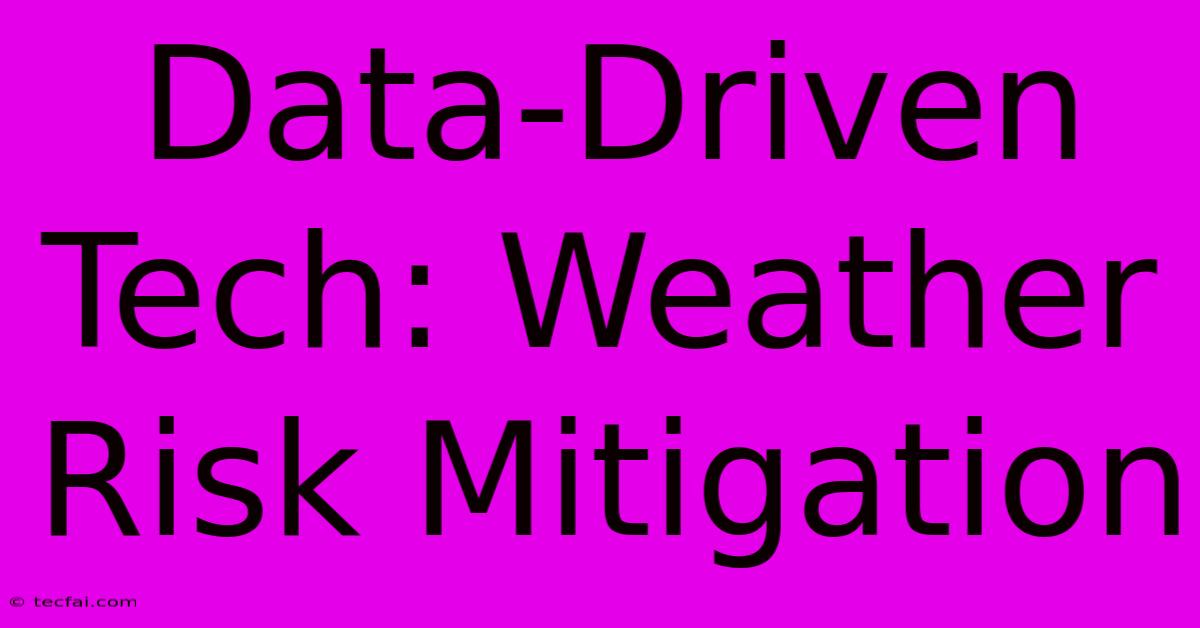Data-Driven Tech: Weather Risk Mitigation

Discover more detailed and exciting information on our website. Click the link below to start your adventure: Visit Best Website tecfai.com. Don't miss out!
Table of Contents
Data-Driven Tech: Weather Risk Mitigation
The weather is a powerful force, capable of causing significant disruptions to businesses and individuals alike. From crop failures to flight delays, the impact of adverse weather conditions can be substantial. However, with the advent of data-driven technology, we are now equipped to better mitigate weather risk and protect ourselves from its potentially devastating effects.
Harnessing the Power of Data
Data is the lifeblood of modern weather risk mitigation. By analyzing historical weather patterns, current conditions, and forecasts, experts can gain valuable insights into the likelihood of specific weather events. This data comes from various sources, including:
- Weather satellites: These satellites provide real-time data on cloud cover, precipitation, and other atmospheric conditions.
- Ground-based weather stations: These stations measure temperature, humidity, wind speed, and other local weather variables.
- Radar systems: These systems use radio waves to detect precipitation and other atmospheric phenomena.
- Numerical weather prediction models: These models use complex mathematical equations to simulate future weather conditions.
Applications of Data-Driven Weather Risk Mitigation
Data-driven technology finds applications across various sectors, enabling businesses and individuals to proactively manage weather-related risks:
Agriculture: Farmers can use weather data to:
- Optimize planting and harvesting times: Understanding the expected weather patterns can help farmers choose the best time to plant and harvest their crops, maximizing yields and minimizing losses.
- Implement irrigation strategies: Data on rainfall and soil moisture can help farmers determine the optimal irrigation schedule, ensuring sufficient water availability while conserving resources.
- Predict potential crop diseases: Weather data can be used to identify conditions that favor the spread of plant diseases, allowing farmers to take preventative measures.
Insurance: Insurance companies can leverage weather data to:
- Price policies more accurately: By understanding the likelihood of specific weather events in different regions, insurers can better assess risks and set premiums accordingly.
- Develop customized insurance products: This allows companies to offer insurance policies tailored to the specific needs of their clients, taking into account their geographic location and potential exposure to weather-related hazards.
- Improve claims processing: Data on actual weather events can help insurers quickly verify claims and expedite the compensation process.
Transportation: Weather data plays a critical role in transportation safety and efficiency:
- Optimize flight paths and schedules: Airlines can use weather data to avoid storms and other hazardous conditions, ensuring safe and on-time arrivals.
- Improve traffic management: Data on road conditions, visibility, and precipitation can help traffic authorities manage traffic flow effectively and minimize delays.
- Provide timely warnings to drivers: Real-time weather updates allow transportation apps and websites to warn drivers about potential hazards and offer alternative routes.
Energy: Data-driven technology helps the energy sector prepare for and mitigate weather-related disruptions:
- Predict electricity demand fluctuations: Data on temperature and weather patterns can help utilities anticipate changes in energy demand, allowing them to optimize power generation and distribution.
- Plan renewable energy projects: Data on wind speed, solar radiation, and other relevant weather factors can be used to select optimal locations for renewable energy installations.
- Manage power outages: Data on potential weather events can help utilities prepare for potential outages, enabling them to deploy resources and ensure faster restoration of power.
The Future of Weather Risk Mitigation
The field of weather risk mitigation is constantly evolving, driven by advancements in data science, artificial intelligence (AI), and machine learning (ML).
- AI-powered forecasting: AI algorithms are being developed to enhance weather prediction accuracy and lead time, providing more precise insights into future weather events.
- Data visualization and analytics: Sophisticated data visualization tools and advanced analytics techniques are making it easier to interpret complex weather data, identify patterns, and extract actionable insights.
- Real-time weather monitoring: The increasing availability of sensors and connected devices is enabling real-time monitoring of weather conditions, providing up-to-the-minute updates for decision-making.
As technology continues to advance, we can expect even more sophisticated and effective weather risk mitigation solutions in the future. By harnessing the power of data, we can become better prepared for the challenges posed by our dynamic weather systems, ensuring safety, resilience, and sustainability for all.

Thank you for visiting our website wich cover about Data-Driven Tech: Weather Risk Mitigation . We hope the information provided has been useful to you. Feel free to contact us if you have any questions or need further assistance. See you next time and dont miss to bookmark.
Featured Posts
-
Steelers Acquire Wr Mike Williams From Jets
Nov 06, 2024
-
Why Vinicius Jr Still Aims For Ballon D Or
Nov 06, 2024
-
Journo Under Fire For English Comments
Nov 06, 2024
-
Election Night Los Alamos Gop Watch Party
Nov 06, 2024
-
Valencia Floods La Liga Continues
Nov 06, 2024
